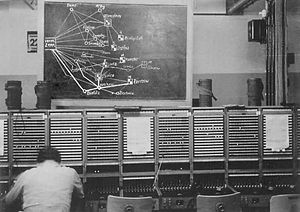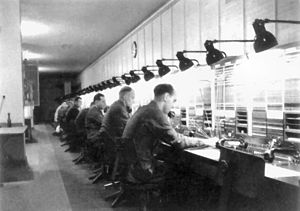A signal corps is a military branch, responsible for military communications (signals). Many countries maintain a signal corps, which is typically subordinate to a country's army.
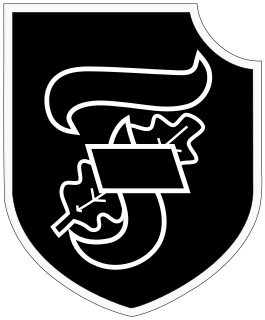
The 10th SS Panzer Division "Frundsberg" was a German Waffen SS armoured division during World War II. The division's first battles were in Ukraine in April 1944. Afterwards, the unit was then transferred to the west, where it fought the Allies in France and at Arnhem. The division was moved to Pomerania, then fought south east of Berlin in the Lusatian area until the end of the war.
Azeri SS Volunteer Formations were recruited from prisoners of war, mainly from the USSR, and also from the countries annexed by Soviet Union after 1939. They were organised to fight against the Soviet Union on the side of Nazi Germany.
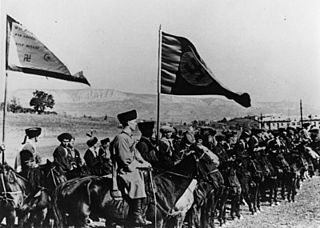
The XV SS Cossack Cavalry Corps was a cavalry corps in the armed forces of Nazi Germany during World War II.

The Upper Rhine High Command, also incorrectly referred to as Army Group Upper Rhine, was a short-lived headquarters unit of the German Armed Forces (Wehrmacht) created on the Western Front during World War II. The Upper Rhine High Command was formed on 26 November 1944 and deactivated on 25 January 1945. The sole commander of this headquarters unit was Heinrich Himmler.
Army Group F was a strategic command formation of the Wehrmacht during the Second World War. The commander of Army Group F served also as the Oberbefehlshaber Südost.

General der Panzertruppe was a General of the branch OF8-rank rank of German Army, introduced in 1935. A General der Panzertruppe was a Lieutenant General, above Major General (Generalleutnant), commanding a Panzer corps.

General der Nachrichtentruppe was a General of the branch OF8-rank of German Army, introduced by the Wehrmacht in 1940.

The 25th Infantry Division was a military unit of the German Wehrmacht. It was later reclassified to 25th Infantry Division (mot.), and in June 1943 to the 25th Panzer Grenadier Division.
Albert Praun was a German general who became the Chief Signals Officer of the Wehrmacht during World War II.

General der Gebirgstruppe was a category of German Army three-star, a new example of the traditional German 'General der' rank introduced by the Wehrmacht in 1940, comparable to the NATO grade OF-8.

Maybach I and II were a series of above and underground bunkers built 20 kilometres south of Berlin in Wünsdorf near Zossen, Brandenburg to house the High Command of the Army and the Supreme Command of the Armed Forces during the Second World War. Along with the military fortress complex Zossen, Maybach I and II were instrumental locations from which central planning for field operations of the Wehrmacht took place, and they provided a key connection between Berlin’s military and civilian leadership to the front lines of battle. The complex was named after the Maybach automobile engine.

Telegraph troops are responsible for the establishment of their own side’s telegraphic communications in war and for the disruption of the enemy’s telegraphic communications. The telegraph troops created in Prussia in 1830 within the New Prussian engineer battalions were established as a separate corps in 1899, which subsequently became the Signal Corps of the Wehrmacht and Waffen SS. Its modern successors are the signal troops and electronic warfare troops. Its predecessors used various optical telegraphic systems.
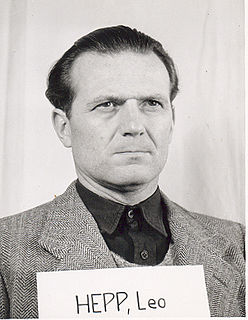
Leo Philipp Franz Hepp was a German military officer, who served as a high-ranking signals officer in the Wehrmacht during World War II and as a lieutenant general in the Bundeswehr after the war.
Johannes Anton Marquart or possibly Marquardt was a German actuarial and insurance mathematician. During World War II, Marquart was employed into the Germany Army Inspectorate 7/VI, in 1940, which would later become the General der Nachrichtenaufklärung. He would eventually become head of Referat Ia of Group IV of the organization in November 1944 engaged in research into German Army hand cryptographic systems. Prior to that period Marquart had been chief cryptanalysis in KONA 5.
The XXIX Army Corps was an infantry corps of the German Army during World War II, active from 1940 to 1945.
The LIII Army Corps was a corps of the German Army during World War II. It was first deployed in 1941 and was active as part of various armies under Army Group Centre until 1944, when it was destroyed during the Soviet Red Army operations Bagration and Kutuzov in June and July 1944. The corps suffered enormous casualties as a result of the Soviet attacks. All of its divisions were destroyed and all but a few of the soldiers were killed or captured by the Soviet Union. A new unit named LIII Army Corps was subsequently deployed in December 1944, when it was assigned to 7th Army and fought on the western front until surrendering to United States Army forces in April 1945.

The XXVI Army Corps was a Wehrmacht army corps during World War II. It existed from 1939 to 1945. It was also known as Corps Wodrig during the Invasion of Poland.
The LXXXVIII Army Corps was an army corps of the German Wehrmacht during World War II. It was formed in 1942 and existed until 1945.
The I Cavalry Corps, initially known simply as the Cavalry Corps, was an army corps of the German Wehrmacht during World War II. It was formed in 1944 and existed until 1945.






